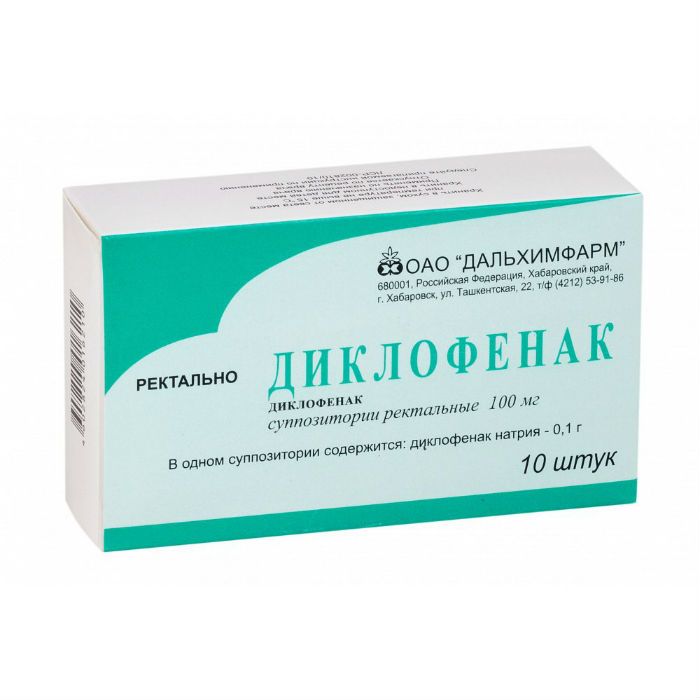Diclofenac | Diclofenac rectal suppository 100 mg, 10 pcs.
Special Price
$27
Regular Price
$34
In stock
SKU
BID472415
Release form
Rectal suppositories.
Rectal suppositories.
Release form
Rectal suppositories.
Packing
10 pcs.
Pharmacological action
Diclofenac is a non-steroidal anti-inflammatory drug (NSAID). It has anti-inflammatory, analgesic and antipyretic effects. It inhibits the COX enzyme in the cascade of arachidonic acid metabolism and disrupts the biosynthesis of prostaglandins.
When used externally, it has anti-inflammatory and analgesic effects. Reduces and relieves pain at the site of ointment application (including joint pain at rest and during movement), reduces morning stiffness and swelling of joints. Helps increase range of motion.
Indications
Inflammatory and inflammatory-activated degenerative forms of rheumatism:
chronic polyarthritis
ankylosing spondylitis (ankylosing spondylitis)
arthrosis
spondylarthrosis
neuritis and neuralgia, such as cervical syndrome, lumbago (lumbago), sciatica
acute gout attacks.
Rheumatic soft tissue lesions.
Painful swelling or inflammation after trauma or surgery.
Non-rheumatic inflammatory pain conditions.
Contraindications
None. aspirin triad)
hypersensitivity to diclofenac and other components of the drug
inflammation of the rectum - proctitis (suppositories)
Dosage and administration
Rectally. Adults: 100 mg 1 time per day, 50 mg 2 times a day or 25 mg 3-4 times a day.
The maximum daily dose is 150 mg.
Children over 12 years of age: 50 mg 1-2 times a day or 25 mg 2-3 times a day.
Side effects
From the digestive system: nausea, vomiting, epigastric pain, anorexia, flatulence, constipation, gastritis up to erosive with bleeding, increased activity of transaminases, drug hepatitis, pancreatitis.
Urinary system: interstitial nephritis.
From the side of the central nervous system: headache, dizziness, disorientation, agitation, insomnia, irritability, fatigue, aseptic meningitis.
From the respiratory system: bronchospasm.
From the hemopoietic system: anemia, thrombocytopenia, leukopenia, agranulocytosis.
Dermatological reactions: exanthema, erythema, eczema, hyperemia, erythroderma, photosensitivity.
Allergic reactions: erythema multiforme, Lyell's syndrome, Stevens-Johnson syndrome, anaphylactic reactions, including shock.
Local reactions: burning, formation of infiltrate, adipose tissue necrosis are possible at the injection site.
Other: fluid retention, edema, increased blood pressure.
Drug interaction
With the simultaneous use of the drug Diclofenac with digoxin, with phenytoin or lithium drugs, it is possible to increase the plasma concentrations of these drugs with diuretics and antihypertensive drugs - it is possible to decrease the effect of these drugs with potassium-sparing diuretics - it is possible to develop hyperkalemia with acetisalicylic acid - a decrease in the concentration of diclofenac in blood plasma and an increased risk of side effects.
Diclofenac may enhance the toxic effects of cyclosporine on the kidneys.
Diclofenk can cause hypo- or hyperglycemia, therefore, when used simultaneously with hypoglycemic agents, monitoring of blood glucose concentration is required.
When methotrexate is used within 24 hours before or after taking Diclofenac, an increase in the concentration of methotrexate and an increase in its toxic effect are possible.
With simultaneous use with anticoagulants, regular monitoring of blood coagulation is necessary.
Storage conditions
Store in a dry, dark place at a temperature not exceeding 25 РC. Keep out of the reach of children.
active substance
Diclofenac
Conditions of release from drugstores
Prescription
Dalhimpharm, Russia
Rectal suppositories.
Packing
10 pcs.
Pharmacological action
Diclofenac is a non-steroidal anti-inflammatory drug (NSAID). It has anti-inflammatory, analgesic and antipyretic effects. It inhibits the COX enzyme in the cascade of arachidonic acid metabolism and disrupts the biosynthesis of prostaglandins.
When used externally, it has anti-inflammatory and analgesic effects. Reduces and relieves pain at the site of ointment application (including joint pain at rest and during movement), reduces morning stiffness and swelling of joints. Helps increase range of motion.
Indications
Inflammatory and inflammatory-activated degenerative forms of rheumatism:
chronic polyarthritis
ankylosing spondylitis (ankylosing spondylitis)
arthrosis
spondylarthrosis
neuritis and neuralgia, such as cervical syndrome, lumbago (lumbago), sciatica
acute gout attacks.
Rheumatic soft tissue lesions.
Painful swelling or inflammation after trauma or surgery.
Non-rheumatic inflammatory pain conditions.
Contraindications
None. aspirin triad)
hypersensitivity to diclofenac and other components of the drug
inflammation of the rectum - proctitis (suppositories)
Dosage and administration
Rectally. Adults: 100 mg 1 time per day, 50 mg 2 times a day or 25 mg 3-4 times a day.
The maximum daily dose is 150 mg.
Children over 12 years of age: 50 mg 1-2 times a day or 25 mg 2-3 times a day.
Side effects
From the digestive system: nausea, vomiting, epigastric pain, anorexia, flatulence, constipation, gastritis up to erosive with bleeding, increased activity of transaminases, drug hepatitis, pancreatitis.
Urinary system: interstitial nephritis.
From the side of the central nervous system: headache, dizziness, disorientation, agitation, insomnia, irritability, fatigue, aseptic meningitis.
From the respiratory system: bronchospasm.
From the hemopoietic system: anemia, thrombocytopenia, leukopenia, agranulocytosis.
Dermatological reactions: exanthema, erythema, eczema, hyperemia, erythroderma, photosensitivity.
Allergic reactions: erythema multiforme, Lyell's syndrome, Stevens-Johnson syndrome, anaphylactic reactions, including shock.
Local reactions: burning, formation of infiltrate, adipose tissue necrosis are possible at the injection site.
Other: fluid retention, edema, increased blood pressure.
Drug interaction
With the simultaneous use of the drug Diclofenac with digoxin, with phenytoin or lithium drugs, it is possible to increase the plasma concentrations of these drugs with diuretics and antihypertensive drugs - it is possible to decrease the effect of these drugs with potassium-sparing diuretics - it is possible to develop hyperkalemia with acetisalicylic acid - a decrease in the concentration of diclofenac in blood plasma and an increased risk of side effects.
Diclofenac may enhance the toxic effects of cyclosporine on the kidneys.
Diclofenk can cause hypo- or hyperglycemia, therefore, when used simultaneously with hypoglycemic agents, monitoring of blood glucose concentration is required.
When methotrexate is used within 24 hours before or after taking Diclofenac, an increase in the concentration of methotrexate and an increase in its toxic effect are possible.
With simultaneous use with anticoagulants, regular monitoring of blood coagulation is necessary.
Storage conditions
Store in a dry, dark place at a temperature not exceeding 25 РC. Keep out of the reach of children.
active substance
Diclofenac
Conditions of release from drugstores
Prescription
Dalhimpharm, Russia
Submit your review to Earn 10 Reward Points click here to login
Write Your Own Review

